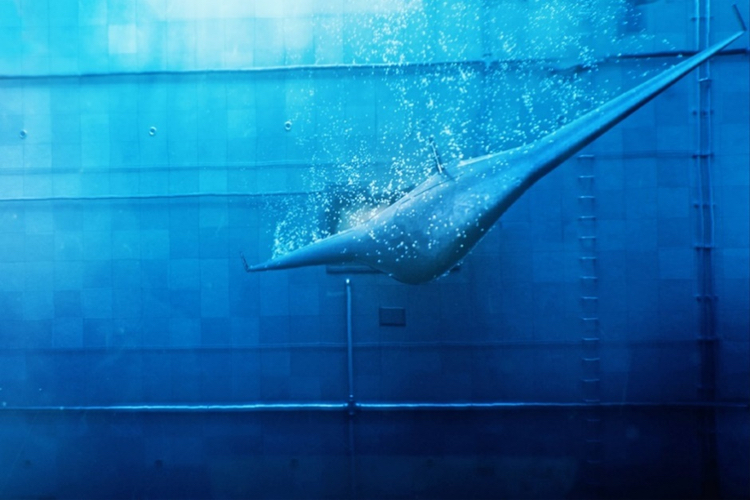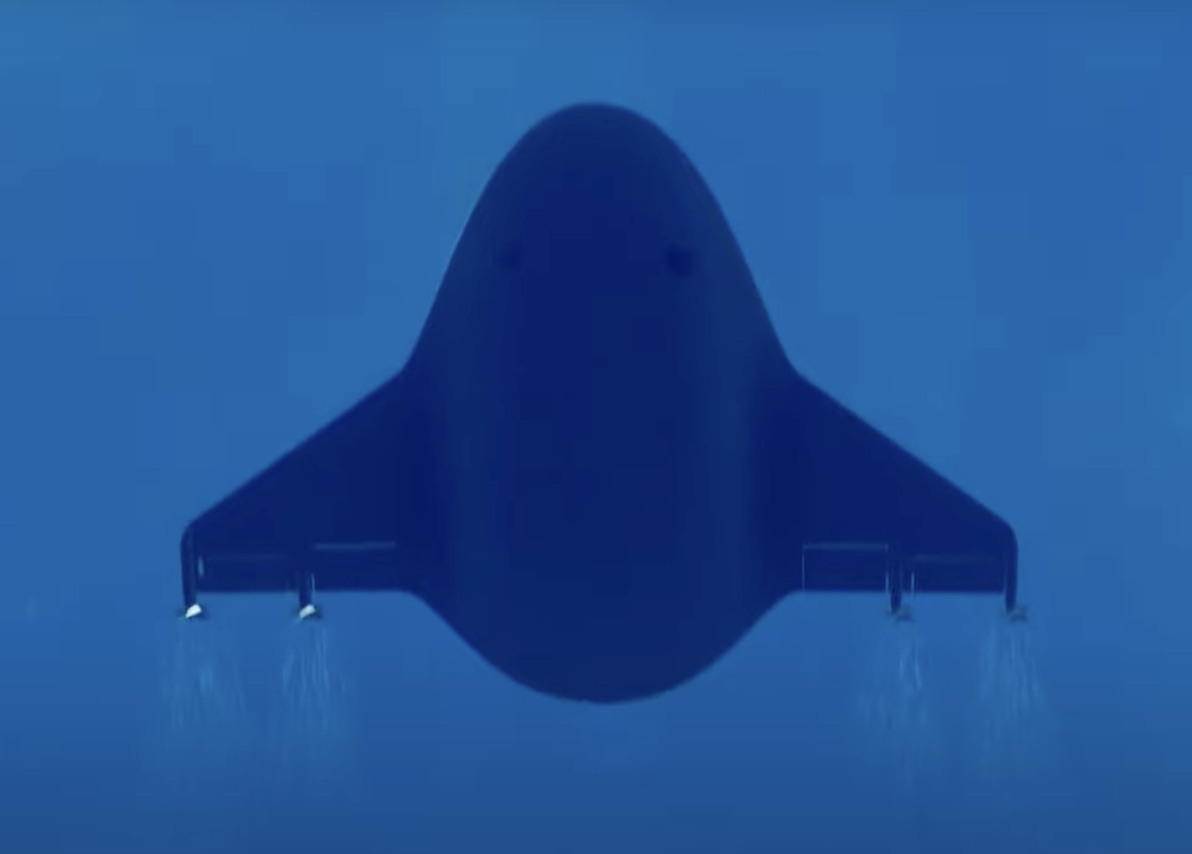Northrop Grumman has completed the construction of its first full-scale Manta Ray uncrewed underwater vehicle, or UUV, prototype. The company is developing the drone under the Defense Advanced Research Projects Agency (DARPA) Manta Ray program, which seeks to demonstrate critical technologies for a new class of very long-endurance payload-capable UUVs.
The news was announced by Northrop earlier today, along with the release of the first image of its full-size testbed, seen in the feature image of this article. Now that its assembly has been finalized, the next step will be to actually test it, which Northrop has previously said will take place at some stage this year.

While details on the overall dimensions of the prototype have not been made public, Northrop describes it as an “extra-large glider” that draws inspiration from the “graceful glide” of the manta ray. In mimicking the shape and movement of the fish after which it’s named, Northrop’s drone features a lifting body that has sea glider-like properties, but is not a glider in the true sense of the term (i.e., it does not strictly employ variable-buoyancy propulsion alone instead of thrusters or propellers to move it forward).
In the video below, released by Northrop in 2022, we see computer-generated footage of Manta Ray being propelled via four small propellers. Imagery of the full-size testbed released by Northrop today also shows the presence of rear propellers, of which there appear to be two, rather than four.


In line with DARPA’s specifications for the project, Northrop Grumman’s Manta Ray prototype is designed for “long-duration, long-range missions in ocean environments where humans can’t go,” the company states.
“[The] Manta Ray Project really came out of the need for understanding more about the ocean environment and being able to have underwater vehicles that last longer than the order of a couple of hours or a couple of days,” according to Manta Ray Program Manager Kyle Woerner. The stated goal of the project is to develop “an autonomous underwater vehicle that’s out operating on its own, harvesting energy and completing whatever mission it’s been given.” You can learn more about DARPA’s aims on unleashing robotic undersea endurance through Manta Ray in the 13-minute episode of the Voices from DARPA podcast below.

In order to achieve this, Northrop’s demonstration vehicle features “energy-saving technologies,” the exact nature of which remain murky, allowing it to anchor on the seafloor and hibernate in a low-power state, Northrop claims.
However, along with Seatrec, a renewable-energy company, Northrop has also designed energy-harvesting technology ostensibly capable of powering Manta Ray over near-unlimited distances and durations. While many UUVs are constrained by the amount of stored energy they can carry onboard, Northrop-Seatrec’s “Mission Unlimited Unmanned Underwater Vehicle (UUV) Station” purports to solve this issue. At present, the Mission Unlimited UUV Station “currently exists as a paper concept only.”

The Mission Unlimited UUV Station combines Seatrec’s Thermal Energy Pod, which extracts energy from the ocean’s thermal gradient — meaning the difference in temperature between warmer mixed water near the surface and colder water below — and converts it to electricity, with Northrop’s invention of a self-insulating, wet-mate electrical connector, enabling submerged underwater connections.
You can learn more about how this works in the videos below.

Northrop also states that its connectors will not only allow for energy transfer between the Mission Unlimited UUV Station and Manta Ray. Via “data bubbles” large volumes of information can theoretically be sent from the UUV to the Mission Unlimited UUV station and then onto a satellite or ship, further maximizing its ability to operate without human intervention.

“Data bubbles are tiny electronic devices that store data,” Brian Theobald, chief engineer for Northrop’s Manta Ray program, states. “When released from the station, they float to the surface and begin using their RF satellite communications antenna to transmit data to shore, to a satellite, or to a ship.”
According to Northrop, the testbed is payload-capable in order to “support a variety of missions.” The specific kinds of payloads it will boast remain unclear; however, DARPA specifies the need for a “large payload capacity” in order for different mission sets to be executed. The design certainly has large internal volume, and video of the concept shows it deploying a tethered vehicle of some kind. Using Manta Ray as a mothership for smaller UUVs would make sense, but really it could conceivably carry many types of payloads, including direct weaponization via a warhead. But missions like undersea mapping, mine detection, and passive surveillance could all be of great use.
The level of autonomy such a vehicle would need to be operationally effective is quite advanced as the communications and command and control issues are more challenging below the waves than above them. However, the infusion of AI into automated piloting and autonomous mission systems is advancing extremely fast, and much of this work is going on in the classified domain for underwater applications.
How exactly the full-size Manta Ray prototype is to be launched, particularly since its size has not been specified, is unclear. It’s possible that it could be deployed via a pier or from a ship — perhaps a well deck of an amphibious assault ship could work too.

Northrop does note that the entire system has been designed for “easy shipment in five standard shipping containers to support expeditionary deployment and in-field assembly worldwide.”
Whether or not the Department of Defense ultimately ends up procuring Northrop’s offering, or some variant or derivative thereof, remains unclear. At this stage, it is just a prototype, and Northrop is not the only company developing a Manta Ray testbed. PacMar Technologies, formerly known as Martin Defense Group which was formerly known as Navatek, is developing a prototype too; a scaled version of which completed in-water tests “to verify sensors, vehicle hydrodynamic performance, and key autonomy behaviors of the glider body” in September last year. Northrop, Navatek, and Lockheed Martin were awarded contracts to work on the Manta Ray program in 2020, of which only the former two were selected to progress to the next stage in late 2021.


Whatever design, or technologies, DARPA ultimately picks, having a “new class” of UVV capable of carrying various payloads for long durations, and possibly blending in with sea life, will be of benefit to the Navy. More broadly, the service is looking to field a wide range of UUVs of various tiers, with “extra-large” being the largest. The Navy has already received its first Orca extra-large uncrewed underwater vehicle, or XLUUV, from Boeing, which you can read more about here.
Possessing various UUV tiers will no doubt be critical in any future maritime fight; and it’s under the waves where new technologies such as Manta Ray could make the biggest impact. This works both ways, too, with adversaries, especially China, having invested heavily in uncrewed underwater vehicles.
With that said, we will be keeping our eyes peeled for our first glimpse of Northrop’s Manta Ray prototype amid testing in the near future.
Contact the author: oliver@thewarzone.com
